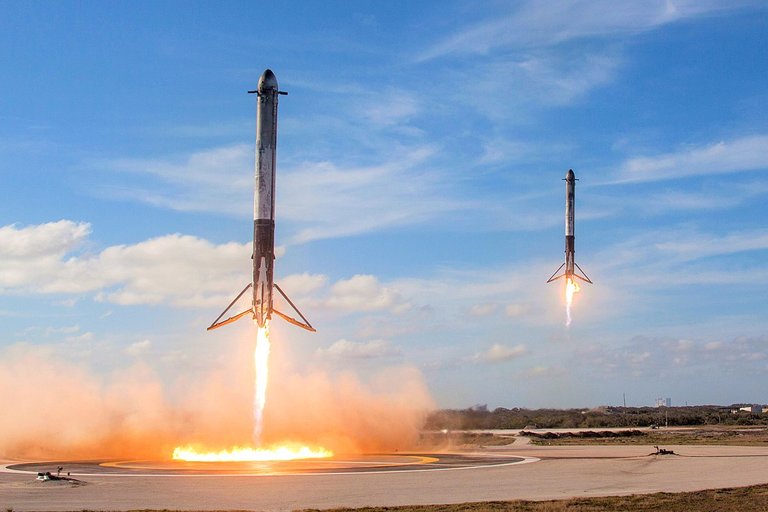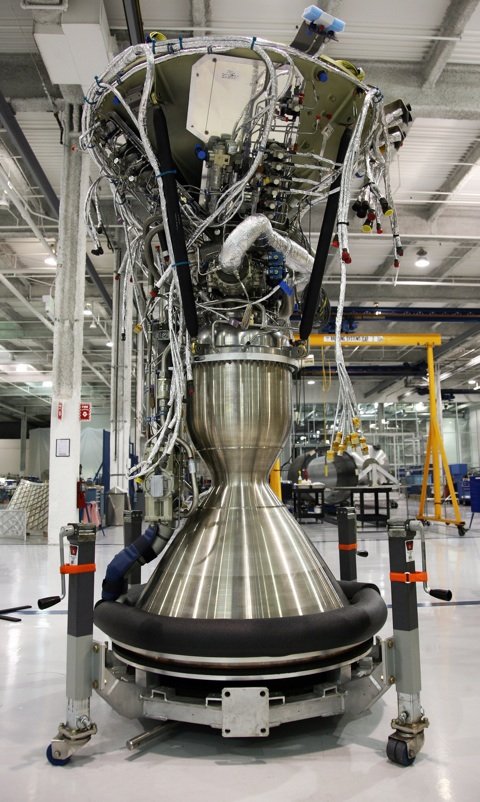Some days ago, I posted an article about the rocket launch system powerful enough to take us to mars, specifically the Space Launch System by NASA, where we discussed the architecture of the space launch system configuration, how the Space Launch System is designed to keep evolving into increasingly more powerful configurations in order to support demanding future deep space missions, its capabilities and potentials, and building the rocket. You can read about it here Here
Now in this post, I will be discussing about the SpaceX Falcon Heavy Rocket, so stay with me.
SPACEX FALCON HEAVY

Commonly known as the most powerful operational rocket in the world, the Falcon Heavy is a partially reusable heavy-lift launch vehicle designed and manufactured by SpaceX. It is derivative of the Falcon 9 vehicle and consists of a more powered Falcon 9 first stage as a central core with two first stages rockets added to the core as strap-on boosters. The big idea is to increase the maximum payload of low Earth orbit to 63,800 kilograms. Below is a comparism of maximum payloads of rockets ever built,
| Rocket | Payload |
|---|---|
| Falcon Heavy | 63,800 kg |
| Falcon 9 | 22,800 kg |
| Delta IV Heavy | 28,790 kg |
| Space Shuttle | 27,500 kg |
| Saturn V | 140,000 kg |
DESIGN
Like I wrote earlier, the Falcon Heavy configuration is made up of a single structurally enhanced Falcon 9 rocket as the center core component, with two Falcon 9 first stages acting as liquid fuel strap-on boosters. Falcon Heavy has more thrust capability than any other existing rocket, with a payload of 64,000 kilograms to Low Earth Orbit [LEO] and 16,800 kg to Trans-Mars Injection [TMI]. The Falcon Heavy rocket was designed from the beginning to be manned to space and to actualize the possibility of flying manned missions to the Moon or Mars.
The Falcon Heavy first stage is powered by three Falcon 9 derived cores, each equipped with nine Merlin 1D engines.
The 27 Merlin 1D engines give the Falcon Heavy a total liftoff thrust of 22,819 kN at sea level, while as the rocket climbs out of the atmosphere, the thrust increases to 24,681 kN. The upper stage is powered by a one Merlin 1D engine with a thrust of 934 kN, an expansion ratio of 117:1 and a nominal burn time of 397 seconds. The engine has been modified for vacuum operation. At launch the center core accelerates to full power for some seconds for additional thrust, then throttles down. This will allow for a longer burn time. After the side boosters separate, the center core accelerates back up to maximum thrust. The inter-stage, which connects the upper and lower stage, is made up of a carbon fiber aluminum core composite structure. The Stage separation between the upper and lower stage occurs via reusable separation collets and a pneumatic pusher system. The Falcon Heavy tank walls and domes are made from aluminum-lithium alloy which is an all-friction stir welded tank. The second stage tank is just a shorter version of the first stage tank and uses most of the same tooling, material and manufacturing techniques. This method reduces vehicle manufacturing costs.All the three cores of the Falcon Heavy includes four extensible landing legs. It uses small grid fins to control the descent of the boosters and center core through the atmosphere, which are deployed from the vehicle after separation. After the side boosters rockets separate, the center engine in each start burns immediately for some seconds to control the booster’s trajectory away from the main craft safely. The legs are then deployed as the boosters turn back to Earth, with each landing softly on the landing pad. The center core of the Falcon Heavy still continues to fire till stage separation, after that its legs are deployed and lands back on Earth somewhere in the Atlantic Ocean on a drone ship. The landing legs are produced with aluminum honeycomb structure and carbon fiber.

By SpaceX - Falcon Heavy Demo Mission, CC0, Link
CAPABILITIES AND MISSIONS
The Falcon Heavy rocket launch system is categorized under the heavy-lift range of launch systems, this means it is capable of lifting 18000 to 45000 kilograms of payload into the LEO. A complete expendable Falcon Heavy rocket can also reach the super heavy-lift category which is above 45000 kilograms to LEO.
The Falcon 9 v1.0 which is the original concept envisioned payloads of 24,700 kg to LEO, but this was increased to 53,000 kg in April 2011 with the Geostationary Transfer Orbit [GTO] payloads up to 12,000 kg. Later in 2011, higher payloads including 19,000 kilograms to GTO, 16,000 kg to trans-lunar trajectory, and 14,000 kg on an orbit to Mars beyond LEO were proposed, but this changed in late 2013 when SpaceX raised the projected GTO payload for the Falcon Heavy rocket to up to 21,200 kg.
The projected LEO payload for the Falcon Heavy kept changing and in April 2017 the payload was raised from 54,400 kg to 63,800 kg. The maximum payload for the Falcon Heavy rocket is reached when the rocket flies a full spent launch profile, which is not recovering any of the three first-stage boosters.

By Lucabon (based on work of Markus Säynevirta and Craigboy and Rressi ) - Falcon rocket family4.svg, CC BY-SA 4.0, Link
| Flight | Proposed Flight Date | Payload | Client | Mission Details | Result |
|---|---|---|---|---|---|
| 1 | February 6, 2018 | Elon Musk’s $100,000 Tesla Roadster car | SpaceX | Elon's red Roadster was sent to space on a Trans-Mars Injection [TMI] orbit. Both side boosters landed successfully, but the center booster suffered two engine failures on re-entry and crashed into the Atlantic Ocean, damaging the drone ship meant to receive it | SUCCESS |
| 2 | June 2018 | USAF STP-2 | United States Department of Defense | To support the U.S. Air Force Evolved Expendable Launch Vehicle [EELV] certification process for the Falcon Heavy rocket | Planned |
| 3 | Late 2018 | Arabsat-6A | Arabsat | Saudi Arabian communications satellite | Planned |
| 4 | 2020 | ViaSat-3 | ViaSat | High-speed Broadband Internet Satellite | Planned |
Conclusion
We have reviewed the NASA Space Launch System, and SpaceX Falcon Heavy Rocket, and even though the Falcon Heavy is already actualized, cheaper and has the ability to transport Man to Mars, I think our best chance for a Manned mission to Mars is with the SLS due to the fact that the SLS makes good use of the existing Shuttle technology and the design is enhanced for maximum terminal velocity and payload.
Thanks for reading, enjoy this short video of the Falcon heavy.
Do not forget to comment, upvote and follow.
If you write STEM (Science, Technology, Engineering, and Mathematics) related posts, consider joining #steemSTEM on steemit chat or discord here. If you are from Nigeria, you may want to include the #stemng tag in your post. You can visit this blog by @stemng for more details.


Hi, I found some acronyms/abbreviations in this post. This is how they expand:
Jeff who? 😂😂😂
OOOOOOOOoooooOoooohhhhhh!